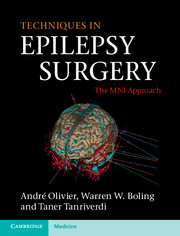Book contents
- Frontmatter
- Contents
- Acknowledgment
- Preface
- 1 History of epilepsy surgery
- 2 The search for the epileptic focus: investigation of the surgical candidate
- 3 Surgical anatomy
- 4 Neuronavigation and preoperative brain mapping
- 5 Stereoelectroencephalography (stereotactic intracranial recording)
- 6 Anesthesia and awake procedure
- 7 Peroperative brain mapping
- 8 Endopial resection (intervascular endopial gyral emptying)
- 9 Surgery of temporal lobe epilepsy: cortico-amygdalohippocampectomy
- 10 Surgery of temporal lobe epilepsy: transcortical selective amygdalohippocampectomy
- 11 Surgery of central area epilepsy
- 12 Surgery of frontal lobe epilepsy
- 13 Surgery of parietal lobe epilepsy
- 14 Surgery of insular lobe epilepsy
- 15 Surgery of occipital lobe epilepsy
- 16 Hemispherectomy
- 17 Callosotomy
- 18 Epilepsy and brain tumors
- 19 Surgical treatment of cortical dysplasias
- 20 Reoperations in failed epilepsy surgery
- 21 Alternative procedures in surgery for epilepsy
- 22 Complications of epilepsy surgery
- 23 Quality of life after epilepsy surgery
- Index
Preface
Published online by Cambridge University Press: 05 October 2012
- Frontmatter
- Contents
- Acknowledgment
- Preface
- 1 History of epilepsy surgery
- 2 The search for the epileptic focus: investigation of the surgical candidate
- 3 Surgical anatomy
- 4 Neuronavigation and preoperative brain mapping
- 5 Stereoelectroencephalography (stereotactic intracranial recording)
- 6 Anesthesia and awake procedure
- 7 Peroperative brain mapping
- 8 Endopial resection (intervascular endopial gyral emptying)
- 9 Surgery of temporal lobe epilepsy: cortico-amygdalohippocampectomy
- 10 Surgery of temporal lobe epilepsy: transcortical selective amygdalohippocampectomy
- 11 Surgery of central area epilepsy
- 12 Surgery of frontal lobe epilepsy
- 13 Surgery of parietal lobe epilepsy
- 14 Surgery of insular lobe epilepsy
- 15 Surgery of occipital lobe epilepsy
- 16 Hemispherectomy
- 17 Callosotomy
- 18 Epilepsy and brain tumors
- 19 Surgical treatment of cortical dysplasias
- 20 Reoperations in failed epilepsy surgery
- 21 Alternative procedures in surgery for epilepsy
- 22 Complications of epilepsy surgery
- 23 Quality of life after epilepsy surgery
- Index
Summary
By the year 2005 the senior author had carried out over 2500 surgical procedures for the treatment of intractable epilepsies. The procedures were all carried out at the Montreal Neurological Institute and Hospital. Most of the surgical approaches and techniques of brain mapping and cortical resections were taught to me by Theodore Rasmussen. I was fortunate enough to practice neurosurgery during a period which saw dramatic improvement in neurosurgical techniques, namely microsurgery and image-guided surgery. Most of the microsurgical techniques had been applied to extracerebral vascular and tumoral lesions. We made a constant effort to apply these techniques to the intragyral endopial resection. In 1992, we started applying neuronavigation to virtually all procedures for epilepsy from preoperative brain mapping to intracranial recording and various types of cortical resections.
The book is mainly concerned with surgical techniques in epilepsy and reflects the authors’ bias concerning the importance of mastering the trilogy of topographic, vascular and functional anatomy of the brain. It is not only a book on surgical techniques but also a guide for neurosurgeons who specialize or will specialize in that field. I like to think of it as a manual for the Fellows in Epilepsy Surgery, to help them understand in a practical way the basic anatomical and physiological mechanisms of epilepsy and the clinical seizure patterns leading to the surgical hypothesis. The best surgical techniques will only be effective if applied to well-selected patients with sound indications. The neurosurgeon must be familiar with all the investigation techniques and especially those of intracranial recording and stimulation. He must develop consultant skills; skills in evaluating the patient, not only as a surgical candidate but as an individual overwhelmed by the occurrence of seizures who could have false expectations of surgery. He must develop skills in teaching basic anatomy to patients and their families for their own understanding. The neurosurgeon must develop also a technique for database collection for each patient where the essential of his history and investigation are gathered and fully analyzed before any decision to operate is reached. This will go a long way to avoid pitfalls which can result not only from lack of knowledge of surgical anatomy and poor surgical techniques but also from inadequate patient selection.
- Type
- Chapter
- Information
- Techniques in Epilepsy SurgeryThe MNI Approach, pp. ix - xPublisher: Cambridge University PressPrint publication year: 2012
- 1
- Cited by



